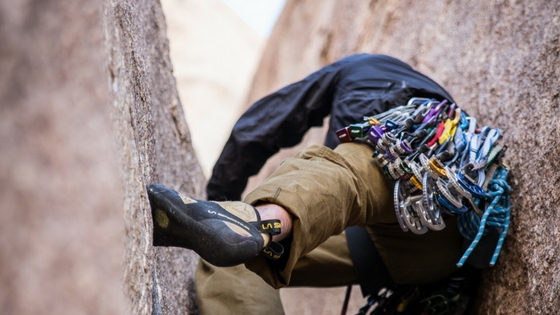Wet, cold, exhausted, shivering and huddled in a two-foot-wide crevice, the wind gusted hard up from below. I was way past “the point of no return”. (There might have been tears.) Leadership is trust.

Scared?
Hello, understatement. I had been crouching 45 minutes dreading my turn-last. I hadn’t seen the cliff yet, but I could feel it. I knew it was there and I knew it was big, 500 feet big. After two days of swimming through potholes in frigid debris-filled waters and 20+ technical rappels, the final descent was all that stood between me and pepperoni pizza. Terrain as unforgiving as it is beautiful, Heaps Canyon is in Southern Utah’s Zion National Park.
500 Feet
A fall here is bad. Like death bad; just ask my camera, he didn’t make it. I am not a great climber, I mix up my knots and shake a little on every rappel. I fear heights, but I do love canyoneering. The group I go with are experts, I do what they say. I follow their lead, I trust them with my life.
Leadership is Influence and Influence requires Trust
Expert climbers trust their equipment, average climbers trust their expert guides and bad climbers trust their good judgement to stay home. Trust is the key to success in climbing in the same way that trust is the key to success in leadership. The more your followers believe in you, the more they trust your judgement and want to follow you. The result is more productivity, more accomplishment.
Great leaders in history, those impacting generations, always have committed followers. Supporters who may not have understood everything but followed out of trust. Jesus had his twelve disciples, Martin Luther King Jr. had the whole Civil Rights Movement, and Mahatma Gandhi had nonviolent supporters in India and worldwide. (BTW all three now have national holidays in their honor). Trust is critical, to spark a movement, to create change, or even just to influence action within your own team.

As a Leader, What Can You Do to Build Trust?
- Avoid Arguments – Leaders must learn to handle shocking news, disappointing results or confrontation with patience, avoiding impulsivity. When arguments occur, defensive shields emerge. Learning and growth cannot happen when defensiveness is present. Taking time to listen and understand and then communicate with respect establishes leadership.
- Admit mistakes – It may appear counterintuitive for a leader to admit a mistake. It is not. Followers recognize that their leader is imperfect, that mistakes will happen. They respect a leader that admits a mistake, remedies an error and learns from the experience. Being vulnerable does not undermine authority, holding blindly to wrong decisions out of pride or arrogance undermines authority.
- Start with the right tone – A leader must build trust from their first interaction with their team. As a new leader, you may be timid or nervous (and that’s ok) but communicate passion, a desire to be strong and an expectation that the team will follow. Starting with the right tone is also vital when addressing issues within the team and performance deficiencies. Positive leadership.
- Tell a story – The ability to use stories as a leader can help you cast the vision. People may not remember what you say but they will always remember how you made them feel. Stories penetrate the feelings of followers. Storytelling ties in with being vulnerable and communicating your progression as a leader and their ability as a follower to grow.
- Give credit where credit is due – As leaders you often receive credit for the work your team completes. Think about the Oscars, one actor receives accolades for a role in a film that took thousands to create. Martin Luther King Jr. may have led the Civil Rights Movement but thousands of followers made the movement successful. Recognize the efforts of your supporters, give credit to those who made you successful. No leader reaches the success summit alone.
- Connect emotionally – Your circle of influence has expanded. You can now connect with friends (new and old) with the click of a button. But the result has created surface level relationships. Acquaintances not as deep and meaningful as relationships once were. As a leader, to gain trust, you must genuinely care about others. Take an interest in their lives and their struggles. Give support where they need support, encourage when they need encouragement and trust to gain trust.
- Recognize the power of knowledge – Always be learning. In #2 above (admit mistakes) we discovered that vulnerability and authenticity increases trust. The next step is growth. Constant learning and improvement. Are you taking the classes, getting the coaching and reading the books necessary to develop the skills required to excel? If you are not, it will be hard for your followers to trust that you are keeping pace with the changing leadership landscape. They will soon be leading you.
- Be curious – In addition to always learning, you must develop a deep curiosity. Not just in how things work, but general curiosity. Learn lessons from competitors, those in other industries and even movies. Be especially curious in the personal lives and interests of your team.
- Be a giver – There is a huge difference between takers and givers. Here is a secret, givers are gaining trust and influence. You have those unfortunate people who only focus on exploiting opportunity and take advantage of others. Would you follow them? True leaders develop the trust of their teams, not through exploiting mistakes, but through serving their needs. Believe in abundance, giving to others starts the receiving process.
- Ask for help – Counterintuitive? Nope. Benjamin Franklin famously taught, “He that has once done you a kindness will be more ready to do you another, than he whom you yourself have obliged.” Again, leaders don’t reach the summit of success alone. Be constantly learning and allow others to use their expertise, their zone of genius, to advance your leadership trust.

Back on Heaps
It took me fifteen minutes to rappel 140 feet to the “Bird Perch”, a three-foot ledge with scarcely room to stand. Uncontrollably shaking, I switched ropes and began the final 300 feet to the Upper Emerald pool (safety). The view was spectacular as I dangled 50 feet from the wall descending to safety. I barely knew my climbing guides before I gave them my trust and risked my life following their lead (surface friends). But, we finished the weekend with an unbreakable bond built on trust. Leadership is influence and influence requires trust. Trust can be earned but it may require a 500-foot death drop to make it apparent.